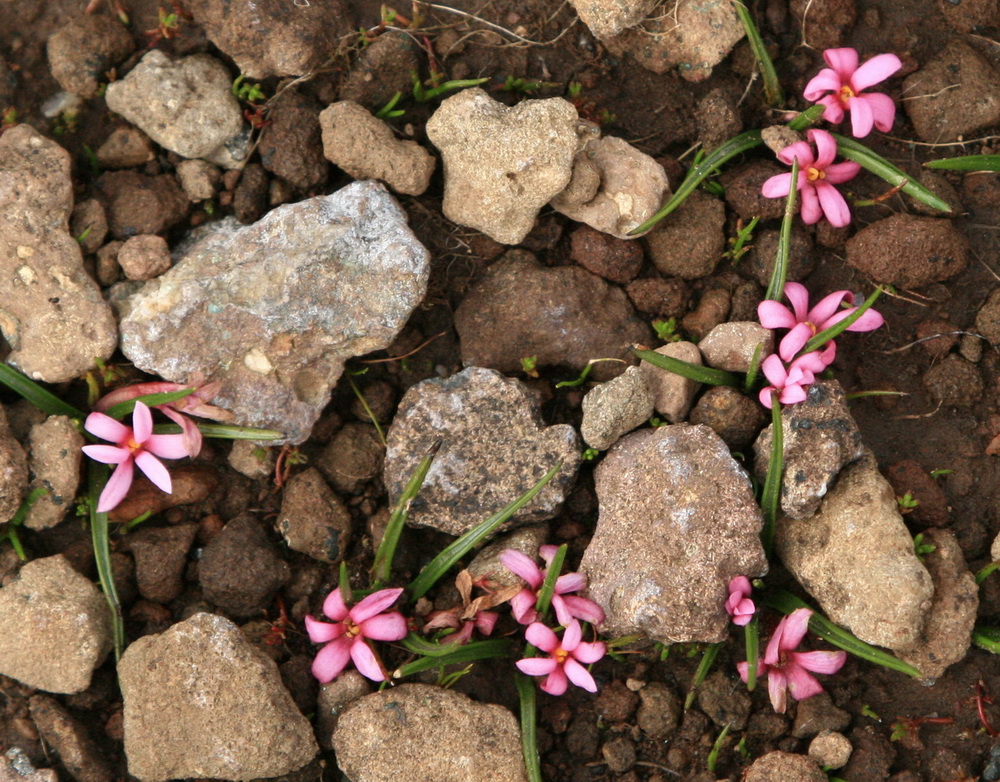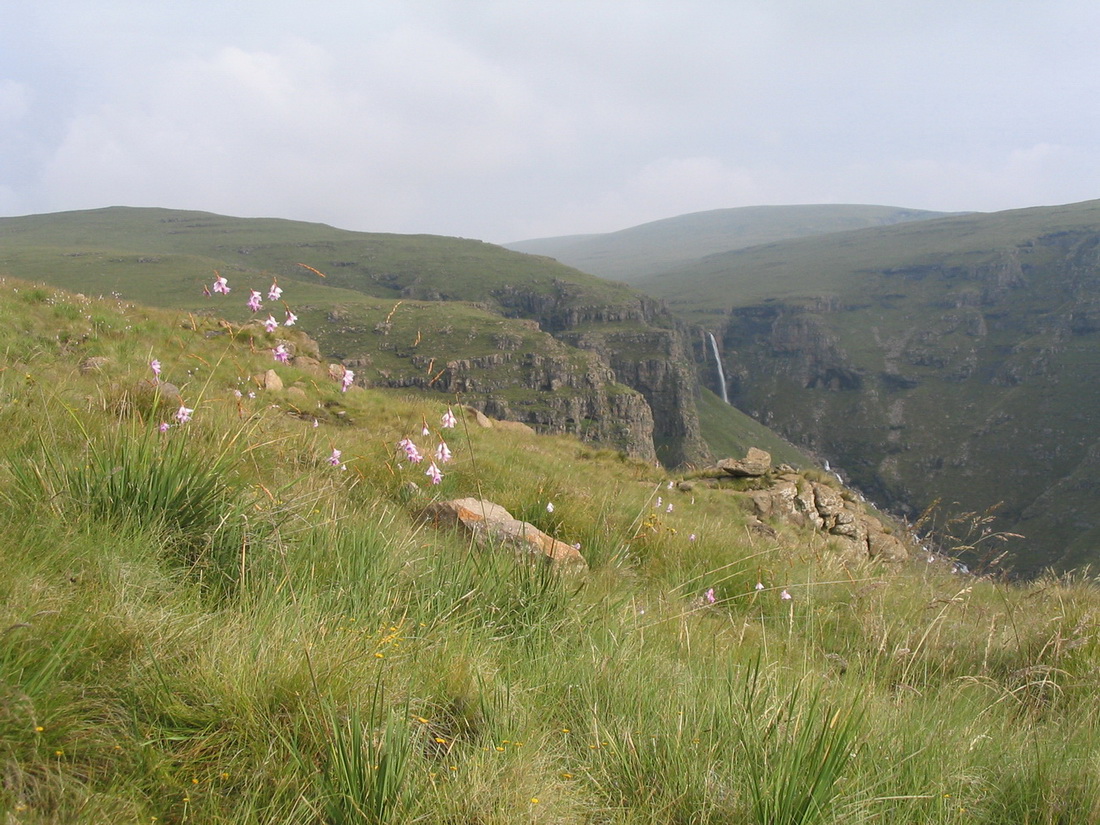Forums:
Some flowers seen while travelling in the Lesotho mountains. I’m going to post the photos in installments starting with plants seen on the Mafika Lisiu Pass, 3090 m, and in the adjoining Bokong Nature Reserve, between 2500 and 3000 m. The underlying rock is basalt covered with a thin layer of fertile soil, seldom deeper than 50 cm.
1. Craterocapsa tarsodes
2. Felicia uliginosa
3. Helichrysum albo-brunneum
4. Helichrysum milfordiae
5. Helichrysum praecurrens
6. Oxalis depressa
7. Rhodohypoxis rubella
8. Dierama robustum
9. Bokong Nature Reserve




Comments
Jennifer Wainwr...
Flowers of the Maloti Mountains, Lesotho continued
Wed, 12/08/2010 - 1:26am1. & 2. Hirpicium armerioides
3. Romulea macowanii
4. Ursinia alpina
5. Ornithogalum paludosum
6. Zaluzianskya ovata
7. & 8. Mafika Lisiu Pass in summer
9. Mafika Lisiu Pass in winter
Trond Hoy
Re: Flowers of the Maloti Mountains, Lesotho
Wed, 12/08/2010 - 3:35amBeautiful scenery, Jenny!
Und suche schöne Pflanzen auch!
Howey (not verified)
Re: Flowers of the Maloti Mountains, Lesotho
Wed, 12/08/2010 - 3:49amI have enjoyed your lovely pics from Lesotho very much. Oh, to grow flowers like that! Especially the Zaluzianskya ovata - that's one I'll be checking the Seed Lists for. Thanks for posting. Fran
Jennifer Wainwr...
Re: Flowers of the Maloti Mountains, Lesotho
Wed, 12/08/2010 - 7:56amHere's another Zaluzianskya, Fran - even better than Z. ovata!
These photos were taken from Moteng Pass (2820 m) in the north east to Letseng-la-Terae (3127 m) passing over Mahlasela Pass (3220 m) and Tlaeeng Pass (3270 m). This area is unfortunately overgrazed so the best botanizing areas are between the rocks where the sheep don’t graze as intensively, or in the fenced off area surrounding the Letseng Diamond Mine.
1. Zaluzianskya rubrostellata
2. Felicia drakensbergensis
3. Eucomis schjiffii
4. Androcymbium striatum
5. Geranium multisectum
6. Helichrysum marginatum
7. Helichrysum adenocarpon
8. Gladiolus longicollis
9. Tlaeeng Pass
Howey (not verified)
Re: Flowers of the Maloti Mountains, Lesotho
Wed, 12/08/2010 - 9:08amMy picks this time are the two Helichrysums. Have two pots of Androcymbium striata but am thinking they must take a few years to get to the flowering stage - are they liliaceae? Seeing lovely pictures like yours is the next best thing to actually being there. Fran
Frances Howey, London, Ontario, Canada, USDA Zone 5b
Trond Hoy
Re: Flowers of the Maloti Mountains, Lesotho
Wed, 12/08/2010 - 11:57amI do agree!! The two Helichrysums are Stars of the performance!
Jennifer Wainwr...
Re: Flowers of the Maloti Mountains, Lesotho
Wed, 12/08/2010 - 1:33pmAndrocymbiums are Colchicaceae, which used to belong to Liliaceae. I don't have any in culture so can't say how long they take to get to flowering size. Helichrysum adenocarpon is a lovely plant, particularly when it's not fully open and the pink bracts are visible.
Richard T. Rodich
Re: Flowers of the Maloti Mountains, Lesotho
Wed, 12/08/2010 - 3:40pmwelcome to the forum, Jenny! Wonderful photos and subjects.
Do the white bracts persist after blooming on the Androcymbium striatum?
Jennifer Wainwr...
Re: Flowers of the Maloti Mountains, Lesotho
Thu, 12/09/2010 - 2:45amI'm fairly sure that the white bracts don't persist after flowering, Rick. The seed capsules are certainly difficult to find amongst all the grass in late summer.
Todd Boland
Re: Flowers of the Maloti Mountains, Lesotho
Fri, 12/10/2010 - 6:00pmSpectacular images Jenny! What time of the year were you there? Must have been later than me (I was at the Sani pass late October) as I saw only a handful of alpines.
Mark McDonough
Re: Flowers of the Maloti Mountains, Lesotho
Fri, 12/10/2010 - 8:57pmThanks Jenny for this posting of intriguing plants and fantastic mountain scenery, a real treat! And a belated WELCOME to NARGS Forum; I'm sorry but I have been a little preoccupied recently.
I'll echo the unanimous response about the Helichrysums, they are truly special. I also like the Felicia species (Aster substitutes in some parts of the world), Hirpicium, Zaluzianskya, and the odd-duck Eucomis schjiffii, I wonder if that last one is hardy given its provenance.
I'm particularly struck by Zaluzianskya, a genus I experimented with a little more than a decade ago; but my memory of the details fades. A Google search for posts I know that I made on several Zaluzianskya species evades google results, yet can be found if one goes to the Alpine-L Archives and searches there! As an aside, this is yet another aspect that I don't like about Listservs like Alpine-L, they don't factor into the universal Google searching. Anyway, I have grown both species shown, Z. ovata and Z. rubrostellata, and another one Z. pulvinata. I wish I had photos to share, but Jenny's photos beautifully capture the charm of these little night-blooming alpines. Here is a series of Alpine-L messages I posted between 1998 and 2000, in the sequence in which they were posted, having to do with Zaluzianskya.
Alpine-L messages on Zaluzianskya 1998 - 2000:
https://listserv.surfnet.nl/scripts/wa.cgi?A2=ind9804&L=ALPINE-L&P=R10254
https://listserv.surfnet.nl/scripts/wa.cgi?A2=ind9906&L=ALPINE-L&P=R58
https://listserv.surfnet.nl/scripts/wa.cgi?A2=ind9906&L=ALPINE-L&P=R817
https://listserv.surfnet.nl/scripts/wa.cgi?A2=ind9907&L=ALPINE-L&P=R939
https://listserv.surfnet.nl/scripts/wa.cgi?A2=ind0007&L=ALPINE-L&P=R3445 Z. pulvinata
https://listserv.surfnet.nl/scripts/wa.cgi?A2=ind0007&L=ALPINE-L&P=R6274 Z. pulvinata by friend Marsha Russell
https://listserv.surfnet.nl/scripts/wa.cgi?A2=ind0007&L=ALPINE-L&P=R6367
Jenny, sorry about this diversion from your topic, but I thought people might like to hear about Zaluzianskya. Many others have grown them, it seems to be a captivating little genus to play around with. Looking forward to more of your postings.
Jennifer Wainwr...
Re: Flowers of the Maloti Mountains, Lesotho
Sat, 12/11/2010 - 9:36amHi Todd, late October would be very early for flowers. I've made 6 trips in all to Lesotho, almost always timed for peak flowering in January/February. This coming year I've planned a trip for Feb/March, more in the hope of finding seed thanin expectation of flowers. I've been trialing various Lesothan alpines at the Botanic Garden where I work and have had success with a number of plants, especially in a garden in the Alps, but it's too wet here in winter for Eucomis schijffii. I grow it in a frame, but no flowers yet.
I was really interested to read your postings on Zaluzianskya rubrostellata, Mark. I haven't tried growing any Zaluzianskyas yet but a friend from Lesotho has sent me seed which I'll be sowing this coming spring. I think it's either monocarpic or a short-lived perennial; the plants I've seen have all been typical pioneer plants growing on disturbed land. The trick will be to get it to sow itself in the garden and be self-sustaining.
Trond Hoy
Re: Flowers of the Maloti Mountains, Lesotho
Sat, 12/11/2010 - 10:59amI have grown a few Zaluzianskya species here in Norway and all have behaved like annuals although some have looked very shrub-like. I've got seed from Silverhill, South Africa.
Jennifer Wainwr...
Re: Flowers of the Maloti Mountains, Lesotho
Sat, 12/11/2010 - 1:30pmTrond, did your Zaluzianskyas ever set seed in your garden?
Trond Hoy
Re: Flowers of the Maloti Mountains, Lesotho
Sat, 12/11/2010 - 3:02pmJenny, I didn't see ripe seed but I wasn't collecting either. At that time I was looking for perennials and found other interesting species like Glumicalyx to be hardy perennials here. I had many South African plants for several years. Most of them have since perished due to hard winters and lack of sun. All my shrubs and trees grow too huge! (I have been through a period of woodland gardening recently!)